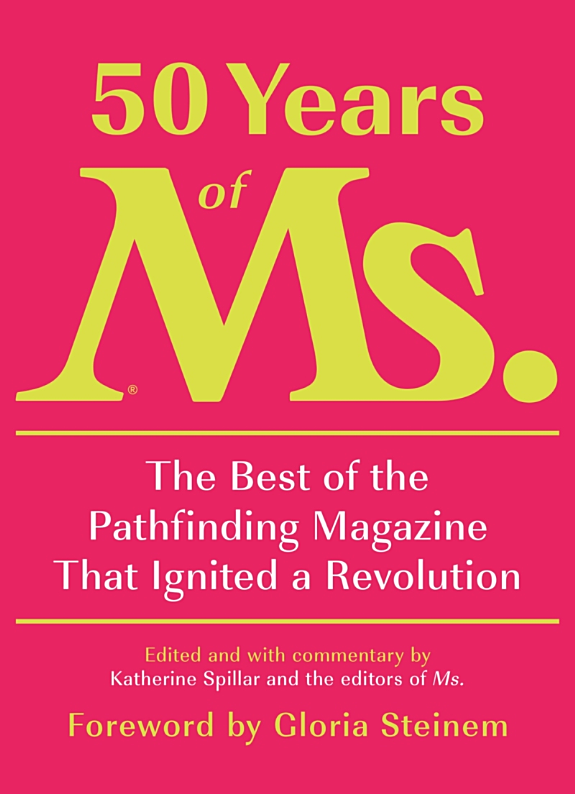In 50 Years of Ms.: The Story of the Magazine That Transformed America, published in 2022, Katherine Spillar, executive director of the Feminist Majority Foundation, provides a comprehensive look at the iconic magazine that has shaped feminist thought for half a century. This isn’t just a history of a publication; it’s a chronicle of the women’s movement itself, told through the lens of the magazine that dared to challenge the status quo. Spillar’s intimate connection to Ms., having served as an editor and frequent contributor, gives the book an authoritative and deeply personal touch. The book emerges at a time where discussions about equality and feminism are more relevant than ever, making this a vital read for anyone seeking to understand the journey of women’s rights in America.
The book unfolds chronologically, starting with the magazine’s inception in the early 1970s as a bold experiment within a predominantly male publishing industry. It meticulously details the early struggles and triumphs, including the daring decision to feature an image of a pregnant woman on the cover, a revolutionary act at the time. The book moves through the decades, chronicling Ms.‘s pivotal role in advocating for reproductive rights, fighting against gender discrimination, and amplifying the voices of marginalized women. Spillar doesn’t shy away from the controversies and challenges Ms. faced, including internal debates about inclusion and the constant financial battles for survival. The pacing is brisk, drawing the reader through the historical narrative with a compelling sense of urgency and purpose. Check it out on Amazon.
Spillar excels in presenting the key figures behind the magazine, particularly its founders, Gloria Steinem and Pat Carbine. She provides a nuanced portrayal of Steinem, not just as a feminist icon, but also as a complex individual navigating the challenges of leadership and public life. Carbine’s often overlooked but crucial role as the business manager is brought to light, demonstrating her shrewdness and dedication. The book is populated with numerous other significant contributors, including writers, activists, and artists, each adding their unique voice and perspective. These profiles give the book an incredible sense of community and shared purpose, illustrating that the fight for equality is not a solitary effort but a collective movement. The book also showcases the evolution of Ms.’s editorial vision, revealing how the magazine adapted to changing social and political landscapes.
Central to the book are the enduring themes of gender equality, social justice, and the power of media to effect change. Ms. was never just a magazine; it was a platform for activism, a tool for education, and a symbol of resistance. It wasn’t afraid to tackle taboo subjects, from sexual harassment to the wage gap, sparking crucial conversations and pushing societal boundaries. Spillar’s narrative demonstrates how the magazine acted as a catalyst for progress, often giving voice to issues that mainstream media ignored. Personally, as a young woman, I remember first encountering Ms. in my school library and feeling like I had found a community that understood my frustrations and aspirations. It was a life-altering moment and a feeling I think many readers will resonate with after reading this book.
Spillar’s writing style is both informative and engaging, making complex social issues accessible to a wide audience. She blends historical analysis with personal anecdotes, creating a narrative that is both intellectually stimulating and emotionally resonant. The book is filled with excerpts from articles, letters, and interviews that showcase the diversity of voices and perspectives within the feminist movement. The structure of the book is chronological, with each chapter covering a specific decade or significant period in the magazine’s history. This allows the reader to easily follow the evolution of the magazine and its impact on society. The detailed index makes it easy to find particular figures, topics, or events, adding to its utility as a reference work. Get your copy here.
This book is not just for those interested in feminism; it’s a compelling read for anyone who cares about social change and the power of media. It provides a valuable historical perspective, showing how far we’ve come and how much work remains. The book’s strength lies in its ability to connect the past to the present, highlighting the continued relevance of the issues Ms. addressed. It serves as both an inspiration and a call to action, reminding us that the fight for equality is an ongoing process that requires vigilance and engagement. It is a testament to the power of collective action and the enduring legacy of a magazine that changed the world. Click to buy.
50 Years of Ms. is a must-read for students of journalism, women’s studies, and social history. It offers practical insights into the workings of a successful activist publication and demonstrates the crucial role that media can play in shaping public discourse. It’s also a valuable resource for activists, offering examples of successful strategies and a reminder of the importance of perseverance. Readers who enjoyed books like My Life on the Road by Gloria Steinem or Feminist Fight Club by Jessica Bennett will find this a compelling and illuminating companion piece. It is a rich and compelling story, meticulously researched, and emotionally resonant. This book leaves a lasting impact, reinforcing the necessity of continued activism and the importance of challenging systems of oppression. Find it on Amazon.

